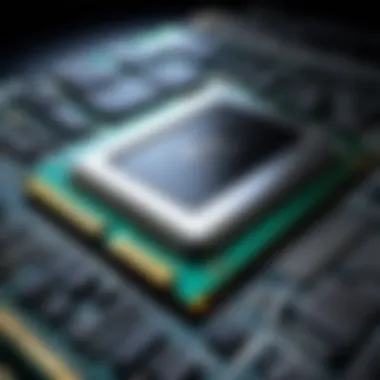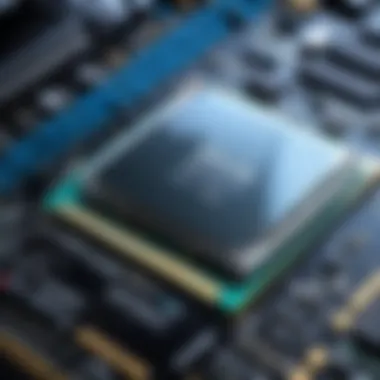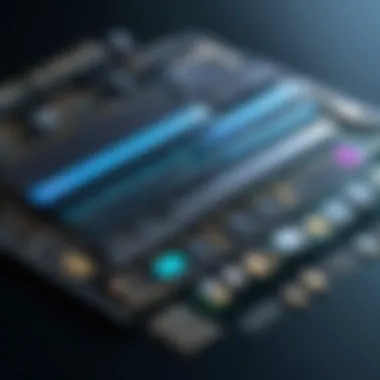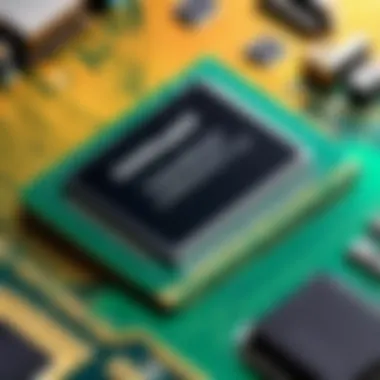Understanding SDRAM and DDRAM: Key Differences


Intro
In the world of computing, memory plays a crucial role in determining performance and efficiency. Two types of memory that significantly impact modern systems are synchronous dynamic random-access memory (SDRAM) and double data rate dynamic random-access memory (DDRAM). Each serves distinct purposes and has unique technologies behind its operation. This article explores the architectural frameworks, operational processes, and practical applications of these memory types. By comprehensively comparing SDRAM and DDRAM, readers will gain valuable insights into their respective advantages and limitations. Understanding these memory technologies is essential not only for IT professionals but also for tech enthusiasts who wish to deepen their grasp of how memory influences overall system performance.
Features Overview
Key Specifications
Both SDRAM and DDRAM have distinct specifications that set them apart. SDRAM operates synchronously with the system clock, eliminating delays in data transfer. Its bandwidth typically ranges from 64 bits to 128 bits. DDRAM, on the other hand, pushes the boundaries further by transferring data on both the rising and falling edges of the clock signal. This results in doubled bandwidth compared to standard SDRAM. Specific specifications include:
- SDRAM: 8-bit, 16-bit, or 32-bit data width options. Frequencies around 100 MHz to 200 MHz are common.
- DDRAM: 64-bit data width with frequencies often exceeding 200 MHz, resulting in higher performance.
Unique Selling Points
The unique selling points for SDRAM include its simplicity and efficiency in basic applications. It is reliable and is widely used in desktop computers and other devices where lower performance requirements exist. DDRAM provides several advantages:
- Enhanced performance due to its double-pumping capability.
- Improved energy efficiency with reduced power consumption across operating frequencies.
- Wider adoption in high-performance computing environments, such as workstations and gaming systems.
Performance Analysis
Benchmarking Results
In terms of benchmarking results, DDRAM clearly outperforms SDRAM. Various tests show that DDRAM can achieve up to 2x faster data transfer rates compared to SDRAM. These statistics indicate that user experiences, particularly in data-intensive tasks, are significantly enhanced with DDRAM.
Real-world Scenarios
Real-world scenarios illustrate the application of SDRAM and DDRAM in various computing environments. SDRAM is sufficient for basic productivity tasks like word processing or web browsing. However, DDRAM is preferred in demanding applications such as video editing, gaming, and data analysis. In professional environments, memory choices impact the system's ability to handle multiple tasks simultaneously, thus affecting productivity.
"The understanding of memory types like SDRAM and DDRAM is essential for optimizing system performance."
As the evolution of these memory technologies continues, it will be interesting to observe how emerging technologies influence their development and application in modern computing.
Prolusion to Memory Technologies
Memory technology plays a vital role in computing. It serves as the backbone that supports data processing and storage. The right memory type influences system performance, responsiveness, and overall efficiency. In modern systems, various memory technologies coexist, with SDRAM and DDRAM standing out due to their widespread use and impact.
For IT professionals and tech enthusiasts, understanding the intricacies of these memory types can aid in optimizing system performance and making informed decisions. The ability to discern the characteristics of SDRAM and DDRAM is crucial when selecting components for various applications, be it for personal computing, enterprise systems, or specialized computing environments.
Overview of Computer Memory
Computer memory refers to the storage components that a system uses to store and retrieve data. It includes both volatile and non-volatile types. Volatile memory, such as RAM, requires power to retain data, whereas non-volatile memory retains data without power. SDRAM and DDRAM are both forms of volatile memory, primarily used for active processing tasks.
The hierarchy of memory technology can be broadly categorized into primary memory, which includes RAM; secondary memory, such as hard drives and SSDs; and cache memory that improves access speed for frequently used data.
Memory operates on a system of addressing where each byte has a unique address, enabling the CPU to retrieve data efficiently. The speed of memory access, measured in nanoseconds, significantly affects processing speed.
Importance of RAM in Computing
Random Access Memory, or RAM, is essential for any computing device. It affects the performance of applications, multitasking operations, and system responsiveness. Here are some key points detailing its importance:
- Speed: RAM provides fast read and write access. It allows the CPU to retrieve data quickly, significantly speeding up processing tasks.
- Multitasking: More RAM enables better multitasking. When running multiple applications simultaneously, the system can manage performance effectively without slowing down.
- Temporary Storage: RAM is used for temporary data storage, essential for active processes. This allows the operating system and applications to access data dynamically.
In summary, RAM is crucial for effective computing, and understanding the specific types of memory like SDRAM and DDRAM leads to informed choices that enhance overall system performance.


"Memory technologies directly impact the efficiency and capability of a system, hence their importance cannot be overstated."
Encompassing a diverse range of functionalities, RAM technologies are at the forefront of enhancing user experience, making the knowledge of these technologies indispensable for anyone involved in the IT and technology sectors.
Understanding SDRAM
In this article, we will explore synchronous dynamic random-access memory, commonly known as SDRAM. Understanding SDRAM is crucial because it serves as a fundamental building block in modern computer systems. It provides high-speed data storage and retrieval, which directly influences system performance. As digital landscapes evolve, the need for efficient memory technologies like SDRAM becomes increasingly evident.
Definition and Functionality
SDRAM is a type of memory that synchronizes with the system bus. This synchronization allows the memory to process data in bursts, enhancing speed and efficiency. Unlike traditional DRAM, which waits for a signal to access data, SDRAM anticipates the data needs of the CPU. This proactive approach significantly increases throughput, making it suitable for high-performance applications.
Architecture of SDRAM
The architecture of SDRAM consists of multiple components that work together to optimize performance. At its core, SDRAM uses banks of memory cells organized in a matrix. Each bank can store bits of data that can be accessed quickly. The memory controller manages these banks, coordinating read and write operations. The design enables simultaneous access to multiple data locations, ensuring effective utilization of bandwidth.
Operational Mechanism of SDRAM
SDRAM operates using a series of commands that affect how and when data is accessed. It begins with a precharge phase, where the memory cells reset to prepare for new data. Then, a row is activated, allowing the corresponding bits to be accessed. Once the data is read, it can be written back promptly or sent to the processor. This mechanism allows for rapid data access and minimizes latency, which is essential for modern computing tasks.
Pros and Cons of SDRAM
Pros:
- Speed: SDRAM is faster than traditional DRAM due to its synchronous operation.
- Efficiency: It can read and write data in bursts, improving overall performance.
- Scalability: SDRAM technology can be expanded to meet increasing demands.
Cons:
- Cost: The manufacturing process of SDRAM can be more expensive than simpler RAM technologies.
- Power Consumption: While efficient, SDRAM can consume more power under heavy workloads compared to other types of RAM.
Applications of SDRAM
SDRAM is widely used in various applications due to its high performance. Common uses include:
- Personal Computers: SDRAM is standard in desktops and laptops, providing the necessary speed for everyday tasks.
- Servers: In server environments, SDRAM facilitates quick data access for running multiple applications.
- Gaming Consoles: High-performance gaming systems rely on SDRAM for smooth graphics and processing.
Exploring DDRAM
Dynamic Random-Access Memory (DDRAM) represents a significant evolution in memory technology, primarily used in modern computing systems. Understanding DDRAM is essential due to its crucial role in system performance and efficiency. This section will dive into the different aspects of DDRAM, including its definition, architecture, operational principles, advantages, limitations, and specific use cases. These elements form the backbone of how DDRAM operates and why it has become a standard in the industry.
Definition and Classification
Double Data Rate Dynamic Random-Access Memory, or DDRAM, is an advanced type of DRAM that enhances the speed at which data is read and written. Unlike traditional SDRAM, which processes data on a single clock cycle, DDRAM transfers data on both the rising and falling edges of the clock signal. This dual-pumping mechanism effectively doubles the data rate, making it a preferred choice for high-performance applications. DDRAM is classified into several versions, notably DDR, DDR2, DDR3, and DDR4, with each iteration offering improvements in speed, efficiency, and latency. The evolution from DDR to its newest form illustrates the continuous pursuit of better performance in computing technology.
Architecture of DDRAM
The architecture of DDRAM is distinctively designed to optimize data flow and enhance performance.
- Banking Structure: DDRAM is organized into multiple banks, allowing simultaneous access and reducing wait times.
- Data Buffers: Buffers manage the data flow between the memory controller and the memory chips, ensuring that data is readily available when needed.
- Burst Mode: DDRAM can access a series of data values in one single request. This feature enhances the throughput significantly.
These architectural components work together to facilitate rapid data transfer and improve overall effectiveness within the memory subsystem.
Operational Principles of DDRAM


The operational principles of DDRAM center on its ability to read and write data more efficiently compared to SDRAM. By utilizing a double data rate mechanism, DDRAM achieves higher bandwidths. When a memory request is made, DDRAM can send and receive data in two cycles of the clock instead of one. This process is complemented by prefetching, where DDRAM anticipates the data needs based on previous requests. Additionally, it employs complex algorithms to manage timing and access times effectively, ensuring that data delivery aligns well with CPU requests.
Advantages and Limitations of DDRAM
DDRAM offers several advantages:
- Increased Speed: Its dual data rate technology significantly enhances read and write speeds.
- Improved Efficiency: DDRAM's design allows for lower power consumption per bit transferred compared to earlier memory technologies.
- Versatility: It is suitable for a wide range of applications, from consumer electronics to high-performance computing.
However, there are limitations:
- Cost: DDRAM can be more expensive than basic SDRAM.
- Compatibility: Not all systems support the most recent DDRAM standards, limiting its use in older hardware.
Use Cases for DDRAM
DDRAM is widely used in various domains, reflecting its importance in modern computing. Its main use cases include:
- Gaming PCs: The need for high-speed graphics processing makes DDRAM essential.
- Servers: Efficient data handling for tasks such as cloud computing relies on DDRAM.
- Mobile Devices: Smartphones and tablets utilize DDRAM for smooth operation of applications and multitasking.
In summary, understanding DDRAM is crucial for identifying the right memory technology for specific computing needs. Its unique characteristics make it a pivotal component in enhancing performance across various platforms.
Comparative Analysis of SDRAM and DDRAM
The comparative analysis of SDRAM and DDRAM plays a vital role in understanding these two prominent types of memory technologies. This section aims to dissect their performance, power consumption, and cost-effectiveness, relevant factors for IT professionals and organizations alike. Given that both SDRAM and DDRAM have been foundations for advancing computing, a thorough understanding enables stakeholders to make informed decisions.
Performance Metrics Comparison
When it comes to performance, SDRAM and DDRAM exhibit marked differences. SDRAM, by design, allows for synchronous operation, which provides an edge in speed compared to older memory types. However, DDRAM, particularly the more advanced generations, improves on this by allowing data to be transferred on both the rising and falling edges of the clock cycle. This means DDRAM may effectively double the data rate without increasing the frequency, resulting in superior performance.
- Latency:
- Bandwidth:
- SDRAM tends to have lower latency in certain scenarios but may become bottlenecked under heavy load.
- DDRAM, while having slightly higher latency, manages to maintain performance consistently in multitasking and high-demand situations.
- DDRAM offers significantly higher bandwidth. Performance benchmarks show that DDR4, for instance, can achieve bandwidths exceeding 25GB/s, whereas standard SDRAM is much lower.
Power Consumption Considerations
Power consumption is another important aspect to consider when analyzing SDRAM and DDRAM. SDRAM has an advantage in terms of low-power requirements, making it a suitable choice for devices where energy efficiency is paramount.
- Voltage Levels:
- Dynamic Power Management:
- SDRAM typically operates at 3.3V. In contrast, DDRAM technologies, especially the recent DDR4 and DDR5, have lowered operating voltages to around 1.2V to 1.35V.
- Although SDRAM can be considered more power-hungry, DDRAM reduces overall energy consumption by maximizing data throughput relative to energy use.
- DDRAM includes dynamic power-saving modes which can significantly reduce electricity usage in idle states, further emphasizing its efficiency over time.
- SDRAM lacks such extensive power management features, which may lead to unnecessary energy expenditure in certain scenarios.
Overall, DDRAM generally offers better power efficiency due to its lower operating voltages and advanced power management features, which enhances its suitability for energy-sensitive applications.
Cost Implications for Businesses
Cost is always a pressing concern for businesses when it comes to selecting memory options. Both SDRAM and DDRAM come with their own cost structures. Here's a breakdown:
- Manufacturing Costs:
- Total Cost of Ownership:
- SDRAM is typically cheaper to manufacture due to its simpler architecture. This makes it attractive for less demanding applications or entry-level systems.
- DDRAM, especially the latest generations, requires more complex manufacturing processes, which can lead to higher costs. However, the performance gains often justify this expense in high-performance settings.


- While SDRAM may have a lower upfront cost, DDRAM's efficiency and performance can lead to overall cost savings in power consumption and productivity.
- Businesses should assess the total cost of ownership over the lifespan of the memory technology to ensure they align their choice with budgetary constraints and performance needs.
In summary, the decision on whether to invest in SDRAM or DDRAM should not solely pivot on initial costs. A comprehensive approach to evaluating long-term benefits, performance, and power savings is essential for making a judicious decision.
Technological Evolution of DRAM
The evolution of Dynamic Random Access Memory (DRAM) is crucial in understanding how memory technologies have advanced and shaped computing. Over the decades, developments in DRAM technology have not only enhanced memory capacities but also improved speed and efficiency, both of which are vital for modern computing demands. Technological evolution in DRAM directly impacts system performance, reduces latency, and optimizes power consumption. Thus, comprehending this evolution lays the groundwork for appreciating the current landscape of memory technologies and innovations.
History of DRAM Development
DRAM has evolved significantly since its inception in the 1970s. The first prototype of DRAM was invented in 1966 by Robert H. Dennard at IBM. It featured a one-transistor, one-capacitor (1T1C) cell structure, allowing for a denser memory design compared to previous technologies. Initial implementations were relatively slow and had lower capacity, but they served as the foundation for future developments.
In the following decades, various improvements were made:
- Introduction of Synchronous DRAM (SDRAM): In the 1990s, SDRAM was introduced, synchronizing memory operations with the system clock. This advancement allowed for faster data access and improved performance.
- Move to DDR Technologies: The early 2000s marked a shift towards Double Data Rate (DDR) technologies, starting with DDR1. This allowed data to be transferred on both the rising and falling edges of the clock cycle, doubling the data rate without increasing the clock speed.
- Continuous Upgrades: Subsequent iterations, such as DDR2, DDR3, and DDR4, offered enhanced speed, lower power consumption, and greater density. Each generation has built upon the last, refining the architecture and operational principles of DRAM.
Today, DDR5 is in the spotlight, promising even higher speeds and efficiency, catering to the growing demands of applications such as gaming, data centers, and artificial intelligence.
Future Trends in DRAM Technology
Looking ahead, the future of DRAM technology holds several exciting possibilities. The drive for faster, more efficient memory continues to be a major focus. Key trends include:
- Increased Bandwidth: Future DDR versions, including research on DDR6, aim to further increase the bandwidth. This is crucial for applications that require rapid data processing, such as machine learning and big data analytics.
- Energy Efficiency Enhancements: As power consumption becomes a critical issue, designers seek methodologies to reduce energy use without sacrificing performance. This could involve new materials or architectures.
- Integration with Non-Volatile Memory: Future DRAM may move towards integration with non-volatile memory types. This could allow for faster data retention and retrieval while keeping costs down.
- Emergence of 3D DRAM: Innovations in three-dimensional (3D) memory architectures are being explored. 3D DRAM stacks memory chips vertically, increasing density and reducing space requirements.
The evolution of DRAM is not merely about memory; it represents a vital cog in the machinery of computing performance and efficiency.
These trends will likely reshape the DRAM landscape and highlight its continuous importance in technological advancements, enabling IT professionals and tech enthusiasts to leverage memory technologies effectively in future innovations.
Evaluating Memory Options for IT Professionals
In today's fast-paced technological landscape, IT professionals face the crucial task of selecting suitable memory options for their systems. The memory type utilized can significantly impact overall performance, efficiency, and operational stability. When evaluating options, understanding the distinctions between SDRAM and DDRAM becomes essential. Each has unique characteristics that can be advantageous or problematic depending on specific requirements and use cases.
Selecting the Right Memory for Your Needs
Choosing the appropriate memory requires careful analysis. IT professionals must consider several factors such as performance metrics, compatibility, and specific workload demands. A well-informed memory choice can enhance system responsiveness and disrupt processes can arise from inadequate memory configuration.
- Identify Usage Patterns: Determining the primary applications and workloads is vital. For gaming or graphic-intensive applications, high-capacity DDR4 may be preferred. For general business tasks, standard SDRAM may suffice.
- Evaluate Performance Requirements: Look at the speed ratings of SDRAM and DDRAM. DDR memory types generally offer greater bandwidth due to their ability to transfer data on both the rising and falling edges of the clock cycle. This can improve data rates significantly for certain applications.
- Consider Compatibility: Ensure that the chosen memory type is compatible with the motherboard. Some systems may only support SDRAM, while others may fully leverage DDRAM features.
Memory Scaling in Enterprise Systems
Memory scaling is a critical aspect for enterprises that experience growth and increased workloads. The capacity of memory must scale to meet evolving demands without compromising performance.
- Scalability Needs: As businesses grow, their systems often must handle larger datasets and more concurrent processes. This necessitates a review of current memory offerings to support growth.
- Cost vs. Performance: Balancing investment in high-performance DDRAM versus cost-effective SDRAM is essential. An intelligent approach can save resources while maintaining system functionality.
- Future-proofing: Investing in technology that will handle upcoming advancements in data workloads ensures that systems remain competitive and efficient.
"Effective memory scalability can dictate the overall health of enterprise IT infrastructure."
Remember that in an enterprise setting, scalability is not just about adding more memory; it's about optimizing the existing resources and planning for the future. By evaluating memory options effectively, IT professionals can ensure their systems remain robust and capable of addressing both current and future challenges.
End and Key Takeaways
The conclusion section serves as a crucial recap of the comprehensive analysis undertaken throughout this guide. Understanding SDRAM and DDRAM is not just about knowing their definitions and functionalities. It sheds light on their architectural nuances, operational principles, and their role in modern computing. This knowledge is fundamental for IT professionals and tech enthusiasts alike, as it supports informed decision-making on memory requirements for varied applications.
Summary of Key Points
Several key points emerge from the article:
- Definition and Functionality: SDRAM and DDRAM represent significant evolutions in memory technology, enhancing data processing capabilities.
- Architectural Details: The architecture of these memory types is distinct, with DDRAM incorporating mechanisms to handle data more efficiently than SDRAM.
- Operational Principles: Both types have specific operational mechanisms that contribute to their effectiveness, with DDRAM achieving higher speeds by reading data twice per clock cycle.
- Advantages and Limitations: SDRAM is simpler and cost-effective, but DDRAM offers superior performance, making it vital for high-demand computing environments.
- Practical Applications: Understanding where these memory types excel helps in choosing the right solution for different technological needs.
Final Thoughts on Memory Technologies
In the fast-paced world of information technology, understanding these technologies ensures that organizations can make educated decisions that support not only current demands but future growth as well.



